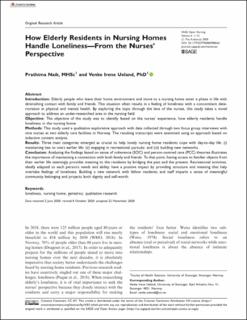| dc.contributor.author | Naik, Prathima | |
| dc.contributor.author | Ueland, Venke Irene | |
| dc.date.accessioned | 2021-01-28T11:25:42Z | |
| dc.date.available | 2021-01-28T11:25:42Z | |
| dc.date.created | 2020-11-28T19:37:08Z | |
| dc.date.issued | 2020-11 | |
| dc.identifier.citation | Ueland, V., Naik, P. (2020) How elderly residents in nursing homes handle loneliness – from the nurses’ perspective. SAGE Open Nursing, 6, DOI: 10.1177/2377960820980361 | en_US |
| dc.identifier.issn | 2377-9608 | |
| dc.identifier.uri | https://hdl.handle.net/11250/2725159 | |
| dc.description.abstract | Introduction: Elderly people who leave their home environment and move to a nursing home enter a phase in life with diminishing contact with family and friends. This situation often results in a feeling of loneliness with a concomitant deterioration in physical and mental health. By exploring the topic through the lens of the nurses, this study takes a novel approach to address an under-researched area in the nursing field.
Objective: The objective of the study was to identify, based on the nurses’ experience, how elderly residents handle loneliness in the nursing home.
Methods: This study used a qualitative explorative approach with data collected through two focus group interviews with nine nurses at two elderly care facilities in Norway. The resulting transcripts were examined using an approach based on inductive content analysis.
Results: Three main categories emerged as crucial to help lonely nursing home residents cope with day-to-day life: (i) maintaining ties to one’s earlier life; (ii) engaging in recreational pursuits; and (iii) building new networks. Conclusion: Analysing the findings based on sense of coherence (SOC) and person-centred care (PCC) theories illustrates the importance of maintaining a connection with both family and friends. To that point, having access to familiar objects from their earlier life seemingly provides meaning to the residents by bridging the past and the present. Recreational activities, ideally adapted to each person’s needs and ability, have a positive impact by providing structure and meaning that help overtake feelings of loneliness. Building a new network with fellow residents and staff imparts a sense of meaningful community belonging and projects both dignity and self-worth. | en_US |
| dc.language.iso | eng | en_US |
| dc.publisher | SAGE Publications | en_US |
| dc.rights | Navngivelse 4.0 Internasjonal | * |
| dc.rights.uri | http://creativecommons.org/licenses/by/4.0/deed.no | * |
| dc.subject | sykepleievitenskap | en_US |
| dc.subject | eldreomsorg | en_US |
| dc.subject | ensomhet | en_US |
| dc.subject | sykehjem | en_US |
| dc.title | How elderly residents in nursing homes handle loneliness – from the nurses’ perspective | en_US |
| dc.type | Peer reviewed | en_US |
| dc.type | Journal article | en_US |
| dc.description.version | publishedVersion | en_US |
| dc.rights.holder | (c) The Author(s) 2020 | en_US |
| dc.subject.nsi | VDP::Medisinske Fag: 700::Helsefag: 800::Sykepleievitenskap: 808 | en_US |
| dc.source.volume | 6 | en_US |
| dc.source.journal | Sage Open Nursing | en_US |
| dc.identifier.doi | 10.1177/2377960820980361 | |
| dc.identifier.cristin | 1853685 | |
| cristin.ispublished | false | |
| cristin.fulltext | original | |
| cristin.qualitycode | 1 | |

